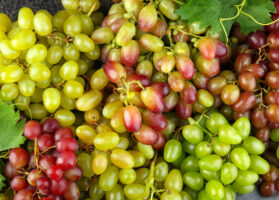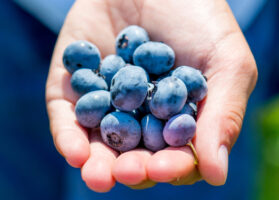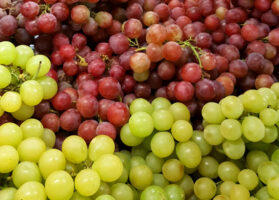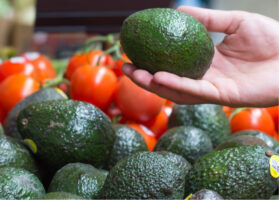Agronometrics in Charts: 2022: Year in Review
In this installment of the ‘Agronometrics In Charts’ series, Sarah Ilyas reviews the top ten fresh produce commodities of 2022 in the US market. Each week the series looks at a different horticultural commodity, focusing on a specific origin or topic visualizing the market factors that are driving change.
The year 2022 witnessed tensions between Ukraine and Russia, impacts of COVID-19, climate change, cost pressures which led to logistical constraints and inflation climbing as high as 9.060% in June 2022 in the US. The kaleidoscopic events of the past year also left a mark on the fresh produce industry. According to the USDA Economic Research Service, the Consumer Price Index for fresh fruits as of November 2022 was 6.6% higher in comparison to 2021. The Producer Price Index for all Citrus fruits was 7.7% higher YOY( year-on-year) and that for all fresh fruits and melons was 15.8% higher YOY. “Inflation has been accelerating since early fall 2021, drought conditions are severe, consumer confidence is low and grocery patterns are switching very rapidly,” says Joe Watson, VP, Retail, Foodservice & Wholesale for IFPA. Below we list our top commodities for the year 2022 based on customer interest.

#1: Blueberries
The top commodity this year was Blueberries. Peru exported 31% more volume than in the same period of the previous campaign. Prices started slipping from week 39 of 2021 owing to higher volumes arriving in the US market. For the 2022-2023 season, Peru expects a 15% growth in the volume of blueberry exports compared to the previous season. As for Chile, An estimated 98,228 tons of fresh blueberries are expected for the 2022-2023 season, according to the Chilean Blueberry Committee. Chilean blueberry volumes are forecast to decrease, however, higher quality is expected as dropping temperatures have enhanced overall fruit quality. Around mid 2022, Berries surpassed beer and avocados as Mexico’s number one agri-food export product.
To learn more take a look at our 2022 review for blueberries:
Agronometrics in Charts: 2022 : Blueberries in Review

#2: Avocados
At number 2 in 2022 were Avocados. The year was marked by prices reaching historically high levels during the first half of the year, however, as the season progressed and supplies from Peru and Mexico increased, prices decreased, reaching 2020 levels. The Peruvian avocado season concluded following a record drop in prices. Higher volumes of fruit and logistical impediments were the primary culprits behind the decline. Although the supply of California avocados this year was slightly higher than last season, the harvest ended earlier than in previous seasons. In early February, the US suspended avocado imports from Mexico. The ban, however, was short-lived. Throughout most of the rest of the year, supplies of Mexican avocados were strong.
To learn more take a look at our 2022 review for avocados:
Agronometrics in Charts: 2022 : Avocados in Review

#3: Raspberries
At number three in 2022 were Raspberries. The year witnessed soaring demand for Mexican raspberries. The crop in California had excellent quality thanks to the very cool spring in 2022, which was very conducive to the growth of raspberries. The season started about a week later than normal, but caused no issues for the harvest. The season saw the lowest prices compared to the past five seasons owing to higher volumes. In week 44, prices fell to $7 per package. Mexico managed to rank as the second largest producer in the world, only behind Russia. According to Aneberries, the total berry market would reach 584 thousand tons in 2023. The new year is projected to be bigger for Mexican raspberries owing to new genetics being tested coming in the next year or two.
To learn more take a look at our 2022 review for Raspberries:
Agronometrics in Charts: 2022 : Raspberries in Review

#4: Blackberries
At number four in 2022 were Blackberries. The year 2022 began with an increased supply of Mexican blackberries in the U.S. market compared to the beginning of 2021. Michoacan, which is Mexico’s main blackberry producer, accounted for 94% of national production. In the first quarter of the year, the state increased its blackberry production by 9% more than in the same period of the previous year. On the other hand, despite forecasts for a bountiful blackberry season, supplies out of Georgia and North Carolina were low, owing to unfavorable weather conditions. Blackberries are going through an unprecedented genetic evolution. Disease pressure has rapidly forced growers to move away from Tupy into new genetics. Growers are looking to these new varieties to improve flavor, quality and yields.
To learn more take a look at our 2022 review for Blackberries:
Agronometrics in Charts: 2022 : Blackberries in Review

#5: Grapes
At number five in 2022 were Grapes. California witnessed a turbulent growing season in 2022 owing to intense heat, which led to challenging growing conditions and higher input prices, leading to a strain on profits. Peru, on the other hand saw a hike of roughly 12% on grape exports. Owing to ongoing conducive growing conditions and expanding growing area, Peru’s output is expected to grow by 53,000 tons to 766,000 tons in the 2022/23 season. Exports are anticipated to surge by roughly 50,000 tons to 585,000 as a result of higher production. According to a recently published USDA GAIN report, the output estimate for Mexico for MY (Marketing Year) 2022/2023 is 347,000 MT, which is 3% less than MY 2021/22. Chilean grapes saw a wide heterogeneity in terms of condition in the 2021-22 season. Following last year’s rebound, table grape production in Chile is expected to drop by 56,000 tons to 737,000 as the country’s grape output continues to decrease.
To learn more take a look at our 2022 review for Grapes:
Agronometrics in Charts: 2022 : Grapes in Review

#6: Strawberries
At number six in 2022 were Strawberries. This year, between January and June, fresh volumes from Southern California were 4% higher than those recorded in the U.S. market last year. Between April and September, the volume of strawberries from Central California was 7% higher than the same period last year. In 2021, Florida’s office of the National Agricultural Statistics Service estimated harvested acres at 10,400, with a reported crop value of nearly $400 million. In late September Florida was impacted by Hurricane Ian, fortunately, about 80% of the industry decided to begin plantings later this year, a week later than normal. Mexico saw heavy rains in August which ravaged over 400 hectares cultivated with strawberries in Guanajuato. Irapuato was the most affected municipality, with nearly 200 hectares impacted by the torrential rains. Crop losses were also recorded in Pénjamo, Abasolo, Dolores Hidalgo, and Acámbaro. Despite the torrential rains, production in major producing areas such as Jalisco was mostly unaffected.
To learn more take a look at our 2022 review for Strawberries:
Agronometrics in Charts: 2022 : Strawberries in Review

#7: Apples
At number seven in 2022 were Apples. In Washington, heat waves experienced at the height of summer hampered bud development in certain apple varieties. Additionally, frigid weather in the spring led to poor pollination and a limited blossom-thinning window, which led to smaller fruit and lower volumes. The crop is estimated to be down 22 million cases this year compared to last year, from 122.3 million cases to 99.8 million. As for Michigan, according to the USDA, apple growers produced 15.6 million bushels in 2021. According to informal estimates, 34-38 million bushels in volume are expected for the 2022-23 season. The New York apple crop was down 15 percent compared to the previou season. Estimates project the apple crop for 2022–2023 to be higher than the previous year.
To learn more take a look at our 2022 review for Apples:
Agronometrics in Charts: 2022 : Apples in Review

#8: Asparagus
At number eight in 2022 was Asparagus. In 2022, Mexico’s production, which peaks between February and April, declined due to adverse weather conditions. The Caborca region of Sonora, one of Mexico’s main asparagus producing states, had a poor winter, with strong winds and frost, contributing to a 70% decrease in production in late February, according to the Caborca Vegetable Producers Association. Low temperatures during the Peruvian winter this year led to slightly lower yields, but Peru’s asparagus suppliers expected supplies to be similar to last season, with production increasing in late September and promotable supplies beginning in October through mid-January, enabling an increase in Peruvian asparagus volumes at the end of the year.
To learn more take a look at our 2022 review for Asparagus:
Agronometrics in Charts: 2022 : Asparagus in Review

#9: Mangos
At number nine in 2022 were Mangos. The Mexican mango season commenced in the first week of January and ran until October. The season was marked by scarce and late rains. However, compared to last year, the export volume to the United States increased by roughly 10 percent. Surges in the costs of cardboard, freight, production inputs, fertilizers, and other inputs led to an overall increase in production costs. Brazilian fruit cultivation registered an 11 percent decrease in the value and volume of fruit exports in the first half of 2022 as a result of inclement weather conditions. The adverse weather in the Sao Francisco Valley during the first half of this year was the major cause of a decrease in mango yield. Peruvian mangos were impacted by lengthy transit times which led to the fruit arriving at destination ports in sub-par condition from. Overall, pricing on mangoes was fairly similar to the last season until week 43 despite added costs on the grower side for shipping and logistics costs almost doubling since last season.
To learn more take a look at our 2022 review for Mangos:
Agronometrics in Charts: 2022 : Mangos in Review

#10: Cherries
At number ten in 2022 were Cherries. During 2022, the supply of local cherries in the United States was lower than the previous season, due to inclement weather. In the case of California, extreme cold in spring resulted in a lighter and shorter crop. In the US market, the volume of cherries from Central California was 46% lower than 2021, and the season was extended to week 24. Pacific Northwest states such as Washington, the main supplier of cherries, Oregon and Idaho faced cold weather during the blooming season, damaging the fruit’s development, causing the smallest cherry crop in nearly a decade, while the cold meant that cherries took longer to develop, causing the harvest to be delayed by a few weeks. In the 2021/22 season, cherry imports to the United States grew by 91.9%.
To learn more take a look at our most read cherry stories this year:
Written by: Sarah Ilyas






